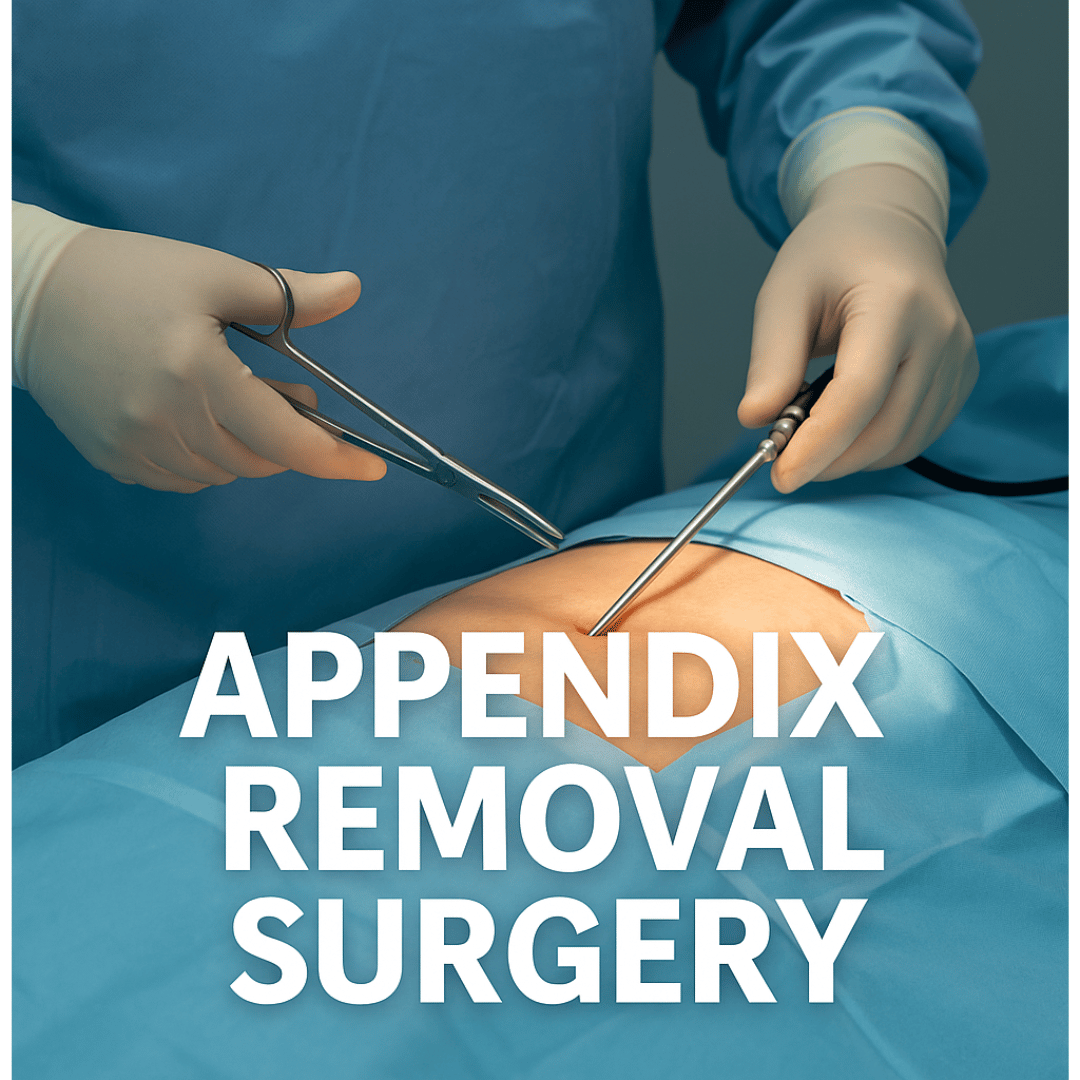Understanding Appendix removal surgery: A Comprehensive Guide to why, when how Appendicitis is treated.
🩺 Appendicitis: Causes, Diagnosis, Complications & Treatment
🧬 Introduction
Appendicitis is a medical emergency that results from inflammation of the appendix, a small, finger-shaped pouch located in the lower right side of the abdomen. Although the appendix does not have a clearly defined function, its inflammation can lead to serious, even life-threatening complications if not treated promptly. Appendicitis is more common in females than males.
🧠 Differential Diagnoses of Appendicitis
When evaluating a patient with right lower abdominal pain, especially a married female of reproductive age, it’s essential to consider the following differential diagnoses:
- Twisted ovarian cyst
- Ruptured uterus during pregnancy
- PID (Pelvic Inflammatory Disease)
Ectopic Pregnancy
- In both male and female:
- Right-sided ureteric calculi
- Urinary tract infections (UTI)
🔬 Diagnosis of Appendicitis
Initial Investigations:
- Complete Blood Count (CBC): Usually shows elevated white blood cells indicating infection.
- Urine Routine Examination (Urine RE): Done to exclude urinary tract infection or ureteric stones.
- Ultrasonogram (USG): Helps visualize an inflamed or swollen appendix, appendicular lump, or abscess.
🧮 Alvarado Score for Appendicitis Diagnosis (Total Score: 0–9)
Mnemonic: MANTRELS
| Symptom | Meaning | Score |
|---|---|---|
| M | Migratory right iliac fossa pain | 2 |
| A | Anorexia (loss of appetite) | 1 |
| N | Neutrophilic leukocytosis | 2 |
| T | Tenderness in right lower quadrant | 1 |
| R | Rebound tenderness | 1 |
| E | Elevated temperature (fever) | 1 |
| L | Leukocytosis with a left shift | 1 |
A score of 7 or more strongly suggests acute appendicitis.
⚕️ Treatment
✅ Primary and Definitive Treatment
Appendectomy – Appendix removal surgery. This can be done through:
- Open surgery (using classical incisions like Gridiron, Lanz, or Rutherford Morrison)
- Laparoscopic surgery (minimally invasive)
⚠️ If Not Treated Timely, Appendicitis Can Lead to:
- Sequelae of appendicitis
- Auto-resolution (rare)
- Appendicular lump – a palpable mass due to inflamed appendix surrounded by omentum and bowel
- Periappendicular abscess
- Burst of appendicular lump
- Localized pus formation
- Peritonitis
- Generalized peritonitis
🩹 Management of Appendicular Lump (If Surgery is Not Immediately Possible)
When an appendicular lump forms (usually after 3–4 days of inflammation), immediate surgery is contraindicated due to high risk of complications. In such cases, conservative management is initiated using the Ochsner-Sherren Regimen.
🩺 Ochsner-Sherren Regimen Includes:
- Nothing per oral (NPO): No food or drinks
- IV fluids: Ringer’s lactate is preferred. Avoid Dextrose-Aqua (DA) unless no alternative is available. DNS (Dextrose Normal Saline) may be used in some cases.
- Nasogastric tube: If vomiting occurs, to decompress the stomach and prevent aspiration pneumonia
- Anti-inflammatory painkillers + Anti-ulcer medications
- Monitoring and maintenance of vital signs
After 6 weeks, if the patient is stable, interval appendectomy is recommended.
💥 If Appendicular Lump Bursts (Rupture):
- ➡️ Emergency laparotomy is performed
- ➡️ Peritoneal cavity washout is essential to remove pus and prevent further infection
🔥 Stages of Appendicitis Leading to Peritonitis
- Stage of Peritonism (0–6 hours): Inflammation begins, causing localized pain and tenderness.
- Stage of Neutralization: The peritoneal fluid’s immune response temporarily neutralizes the infection, giving a false sense of symptom relief.
- Stage of Bacterial Peritonitis (after 6 hours): Bacteria spread throughout the peritoneum, leading to generalized peritonitis, which can be fatal if not treated urgently.

🩻 Surgical Incisions for Appendectomy (Appendix removal surgery)
- Gridiron Incision: Classic oblique incision at McBurney’s point
- Lanz Incision: Transverse and more cosmetic
- Rutherford Morrison Incision: Used in complicated cases
- Skin crease incisions: For cosmetic healing in laparoscopy
✅ Conclusion
Appendicitis is a serious and time-sensitive condition. Early diagnosis, proper differential evaluation, and prompt treatment are essential to avoid complications. In cases where surgical delay is necessary, conservative treatment should be carefully managed. Always seek immediate medical attention if appendicitis is suspected.
According to the Mayo Clinic, appendicitis typically starts with sudden pain near the navel and can quickly become severe in the lower right abdomen.
Table of Contents
You may also Like Chickenpox and Shingles: 7 Essential Facts You Must Know About VZV Infection














